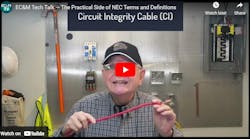In this EC&M Tech Talk, Randy Barnett covers five topics regarding energy storage systems (ESSs). Article 706 Energy Storage Systems first appeared in the Code in 2017, though energy storage was around long before making it into the NEC. The video follows a logical format for understanding these systems and the basic requirements.
- The definition for ESSs is found in NEC Art. 100. Randy breaks down the definition into practical terms.
- The different types of energy storage are discussed concentrating on what is typically installed and maintained in the field today by electrical workers.
- Since most ESSs use batteries for storing energy, battery safety is covered based on the battery safety information found in the NFPA 855, Standard for the Installation of Stationary Energy Storage Systems.
- A one-line diagram is used to describe how the ESS works. Where does the energy come from, how is it stored, and the use of the interactive inverter to tie into the utility.
- Each of the six parts of Art. 706 Energy Storage Systems is given an overview. Listing requirements, nameplate data, conductor ampacity, and disconnecting means are some of the more important topics for installation. Flow batteries and flywheel ESS are each found in separate parts.



